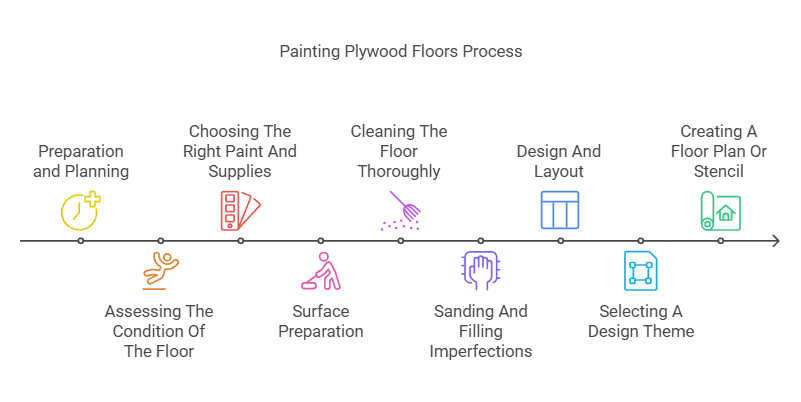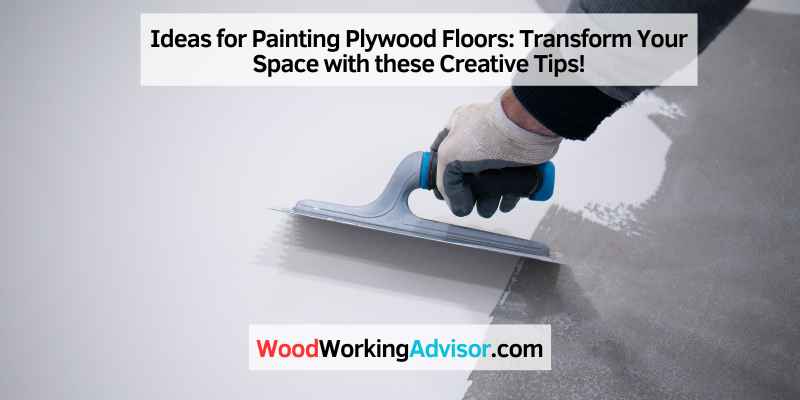For painting plywood floors, consider using durable floor paint or sealing with clear polyurethane for protection. Choose colors and patterns that complement your space and apply a primer for better adhesion.
When updating your home, painting plywood floors can be a cost-effective and stylish solution. By carefully selecting the right materials and design, you can transform your floors into a statement piece. Whether you prefer a classic, modern, or eclectic look, there are endless possibilities for customizing your plywood floors.
With proper preparation and execution, your painted plywood floors can enhance the overall aesthetic of your room while providing durability and easy maintenance. Let’s delve deeper into some creative ideas for painting plywood floors and unleash your inner artist.
Preparation And Planning
When it comes to painting plywood floors, proper preparation and planning are key to achieving a successful outcome. Adequately preparing the surface and selecting the right paint and supplies are essential steps that can make a significant difference in the final result.
Assessing The Condition Of The Floor
Before starting the painting process, carefully assess the condition of the plywood floor. Look for any cracks, holes, or uneven areas that may need to be filled or repaired prior to painting.
Choosing The Right Paint And Supplies
When choosing paint for plywood floors, opt for durable and high-quality options specifically designed for floors. Consider factors like color, finish, and suitability for high-traffic areas.
Surface Preparation
For painting plywood floors, surface preparation is crucial. Start by cleaning the floor thoroughly and sand it to remove any imperfections. Apply a coat of primer to ensure the paint adheres properly and finish with a durable floor paint for a long-lasting finish.
Creating a durable and beautiful painted plywood floor requires thorough surface preparation. Prior to painting, follow these essential steps to ensure a successful finish:
Cleaning The Floor Thoroughly
Sweep away all debris and cleanse the surface with a damp cloth to remove any dirt or grime. Next, use a mild detergent to scrub the floor and rinse off thoroughly. Allow the surface to dry completely before proceeding.
Sanding And Filling Imperfections
Begin by sanding the plywood floor to create a smooth and even surface for painting. Fill any cracks, holes, or gaps with wood filler and sand again for a seamless finish. Remove all dust and debris to ensure proper paint adhesion.

Design And Layout
When painting plywood floors, the design and layout play a crucial role in transforming the space into a visually appealing and unique area. From selecting a design theme to creating a floor plan or stencil, these aspects are essential in ensuring the desired aesthetic and functionality of the painted floors. In this section, we’ll explore the key considerations and processes involved in designing and laying out painted plywood floors.
Selecting A Design Theme
When it comes to selecting a design theme for painted plywood floors, it’s essential to think about the overall style and atmosphere of the space. Whether you prefer a modern, rustic, or eclectic look, choosing a design theme sets the tone for the entire painting project. Consider elements such as color schemes, patterns, and motifs that align with your design theme, ensuring a cohesive and harmonious visual appeal throughout the space.
Creating A Floor Plan Or Stencil
One effective way to ensure a well-planned and visually appealing outcome for painted plywood floors is by creating a floor plan or stencil. Utilizing a floor plan allows you to strategically map out the design layout, including the placement of patterns, borders, or artistic motifs. On the other hand, creating a stencil provides a detailed guide for applying intricate patterns or designs with precision and consistency. By preparing a floor plan or stencil, you can effectively visualize the layout and ensure a seamless execution of your design vision.
Painting Techniques
Discover innovative painting techniques for transforming plywood floors with unique ideas. From stenciling to faux finishes, experiment with colors and patterns to create a personalized and stylish floor design. Enhance your space with these creative painting techniques for plywood floors.
Applying Primer And Base Coats
Applying primer and base coats is an essential step in painting plywood floors. Primer helps to create a smooth surface, allows the paint to adhere better, and ensures better coverage. Before applying the primer, make sure the floor is clean and free from any dust or debris. A good quality primer suitable for plywood is recommended to achieve the best results. Once the primer is dry, apply a base coat that will serve as the foundation for your chosen paint colors. This base coat will provide an even surface and enhance the durability of the painted plywood floor.
Exploring Creative Painting Methods
When it comes to painting plywood floors, there are various creative techniques you can explore to add a unique touch to your space. These methods allow you to unleash your creativity and transform your plain plywood floors into beautiful works of art. One popular technique is creating patterns or designs using stencils. Stencils offer endless possibilities, allowing you to create intricate designs or simple geometric shapes.
Another creative method is faux painting, which involves mimicking the appearance of natural materials such as wood or stone. This technique adds depth and texture to your plywood floors, giving them a realistic and visually appealing look. Moreover, you can also consider using multiple colors to create a vibrant and eye-catching floor.
Here are some additional painting techniques you can use to elevate the look of your plywood floors:
- Stripes: Use painter’s tape to create stripes of different widths and paint each section with a different color. This technique can make your floor stand out and adds a playful touch to any room.
- Stenciled borders: Choose a decorative stencil with a border design and paint it along the edges of your plywood floor. This adds a unique and elegant touch to the overall appearance.
- Ombre effect: Create a gradient effect by blending two or more colors. Start with one color at the corner of the room and gradually transition to another color or lighter shade as you move across the floor. This technique adds depth and visual interest to the space.
- Checkerboard pattern: Paint alternating squares in two different colors to create a classic and timeless checkerboard pattern. This technique works well in kitchens, bathrooms, or any space where you want to add a touch of traditional charm.
In conclusion, by applying primer and base coats as well as exploring creative painting techniques, you can transform your plywood floors into stunning focal points. These techniques allow you to unleash your creativity and personalize your space, giving your floors a new and refreshed look. So go ahead, grab your paintbrush, and let your imagination run wild!
Sealing And Maintenance
Discover effective tips to paint plywood floors with a focus on sealing and maintenance. Enhance durability and aesthetics through proper preparation and quality products. Ensure long-lasting results for your flooring project with these innovative ideas.
Choosing The Right Sealant
When it comes to sealing your painted plywood floors, it’s important to choose the right sealant to protect and enhance the longevity of your floor. There are a few options to consider, each with its own benefits and considerations.
Polyurethane Sealant: This is a popular sealant choice for plywood floors as it provides a durable and protective finish. It creates a hard and glossy surface that is resistant to scratches, stains, and moisture. Additionally, polyurethane sealants are available in both water-based and oil-based variants, making it easier to find one that suits your preferences. When applying polyurethane sealant, make sure to follow the manufacturer’s instructions and allow sufficient drying time between coats.
Epoxy Sealant: Epoxy sealants are known for their excellent durability and resistance to heavy foot traffic and chemical spills. These sealants create a strong, seamless, and glossy surface that is easy to clean and maintain. However, the application process for epoxy sealants can be more involved, involving mixing resin and hardener and applying multiple coats. It’s important to carefully follow the manufacturer’s instructions for the best results.
Water-based Sealant: Water-based sealants are an environmentally friendly option that dries quickly and emits fewer fumes compared to oil-based sealants. They provide a durable and protective finish that is resistant to wear and tear. Water-based sealants are available in various sheen levels, from matte to high gloss, allowing you to customize the appearance of your floor. As with any sealant, it’s essential to properly prepare the surface and follow the manufacturer’s instructions for optimal performance.
Tips For Long-term Floor Maintenance
Proper maintenance is key to keeping your painted plywood floors looking their best for years to come. Here are some effective tips to help you maintain the beauty and integrity of your floor:
- Regular Cleaning: Keep your floors clean by sweeping or vacuuming regularly to remove dirt and debris. Use a damp mop with a gentle cleaner specifically designed for painted floors to maintain their shine.
- Protective Measures: Place doormats at entryways to trap dirt and prevent it from being tracked onto your floor. Use protective pads or furniture glides under heavy furniture to avoid scratches and dents.
- Avoid Harsh Chemicals and Abrasives: Harsh cleaning chemicals and abrasive cleaners can damage the finish of your painted floors. Opt for gentle cleaners and avoid using abrasive scrub brushes or pads.
- Touch-Up Paint: Over time, painted floors may develop small chips or scratches. Keep a small amount of the paint used for your floors handy to touch up any imperfections as they occur.
- Reapply Sealant: Depending on the level of foot traffic, it’s recommended to reapply sealant every 2-3 years to maintain the protective barrier on your floor. Follow the manufacturer’s instructions for applying the sealant properly.
Taking these steps for sealing and long-term maintenance will help ensure that your painted plywood floors remain beautiful and durable for years to come. Remember to choose the right sealant for your specific needs and stay consistent with your maintenance routine to preserve the beauty of your floors.
Frequently Asked Questions Of Ideas For Painting Plywood Floors
Q: Can You Paint Plywood Floors?
A: Yes, plywood floors can be painted to give them a fresh new look. By properly preparing the surface and using the right paint, you can achieve a durable and beautiful finish that will transform your plywood floors.
Q: What Type Of Paint Should I Use For Plywood Floors?
A: It is recommended to use a high-quality floor paint that is specifically designed for use on plywood. Look for a paint that is durable, water-resistant, and suitable for high-traffic areas. Acrylic or latex paints with a satin or semi-gloss finish are popular choices for plywood floors.
Q: How Do I Prepare Plywood Floors Before Painting?
A: Before painting plywood floors, it is important to thoroughly clean the surface and remove any dirt, dust, or debris. Sanding the floor lightly with fine-grit sandpaper will help to smooth out imperfections and create a better surface for the paint to adhere to.
Applying a primer is also recommended to improve paint adhesion.
Q: Do I Need To Apply A Sealer Or Topcoat After Painting Plywood Floors?
A: Applying a sealer or topcoat after painting plywood floors is highly recommended to protect the paint finish and increase durability. A clear polyurethane sealer or a floor-grade polyurethane topcoat can help to prevent scratches, stains, and wear on the painted surface.
Conclusion
Incorporating creativity and color into your plywood floors can transform any room. Whether you opt for stenciling, patterns, or a solid color, painting your plywood floors offers endless design possibilities. By following these ideas, you can add a personal touch to your space while also increasing its aesthetic appeal.

